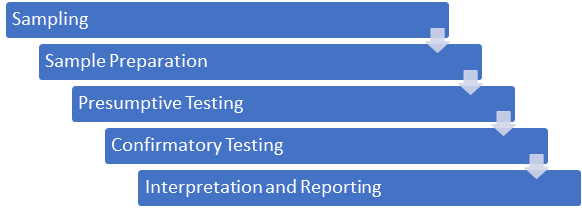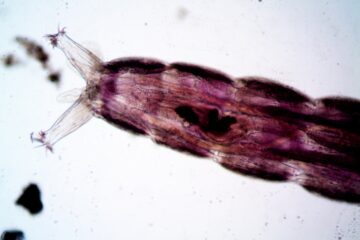![]()
Introduction
Forensic seized-drug analysis standards are concerned primarily with the analysis, sampling, and identification of seized drugs. Serving to promote analysis that is consistent and reliable, forensic drug analysis standards cover the education and training of the forensic analysts involved, continuing to delve further into the standard guides for microcrystal testing of cocaine, amphetamine, methamphetamine, phencyclidine (PCP), and its analogs.[1]
The analysis of seized drugs is a critical component of combatting illicit drug abuse. From the moment suspected drug evidence is submitted to the laboratory, quality assurance practices are in place to ensure scientifically valid results can be reported. Several scientific techniques are applied to the analysis of seized drug evidence. The data generated from these techniques allows the analyst to determine the substance’s identity.[2] This analysis helps law enforcement and also helps in formulating drug policy. These seized drug analysis standards are provided to ensure safety, effectivity, and uniformity in laboratories.
Legal authorities require scientific identification of many medications and banned drugs to enforce laws. These laws for drug offenses can vary from fines to the death penalty. The forensic result helps them in determining the level of severity of the offence. Laws are also implemented keeping in mind the effect of a particular drug. Sanctions are also imposed for possession of certain fatal drugs in most countries. Other than this, there are three primary advantages to testing drugs before they are consumed: short- and long-term adverse effects (including overdose and fatality) can be avoided by the person using the substance; other institutions (such as hospitals) and public health authorities can be made aware when a lethal or novel substance begins to circulate; and, a global picture of drugs in circulation can be generated.[3]
Who Conducts the Analysis?
Forensic chemists subject the evidence collected to several tests in a laboratory to determine the substance and whether it is an illegal drug. But the analyst also has to meet certain educational and training requirements. The Scientific Working Group for the Analysis of Seized Drugs (SWGDRUG) publishes recommendations for minimum levels of education, training, and continuing education for analysts. A trained forensic scientist who specializes in drug chemistry usually performs this test. Evidence submitted for testing may contain many compounds. The duty of the analyst(or the forensic chemist) is to separate all the individual compounds and compare each of their characteristics with the reference material. And then determine the nature of the substance.
Drug Analysis Workflow

Drug Testing Standards
The Scientific Working Group for the Analysis of Seized Drugs’ (SWGDRUG) Recommendations provides techniques that may be incorporated within an analytical scheme for the identification of a substance[4].
| Category A | Category B | Category C |
| Infrared spectroscopy | capillary electrophoresis | Colour test |
| mass spectrometry | gas chromatography thin-layer chromatography | Fluorescence spectroscopy |
| nuclear magnetic resonance spectroscopy | ion mobility spectrometry microcrystalline tests | Immunoassay |
| Raman spectroscopy | liquid chromatography pharmaceutical identifiers | Melting point |
| cannabis only: macroscopic examination microscopic examination | Ultraviolet spectroscopy |
The Scientific Working Group for the Analysis of Seized Drugs recommends that laboratories adhere to the following minimum standards:
- When a validated Category A technique is incorporated into an analytical scheme, then at least one other technique (from either Category A, B, or C) must be used.
- When a Category A technique is not used, then at least three different validated methods must be employed.
- For the use of any method to be considered of value, test results must be considered positive. Although negative-test results provide useful information for ruling out the presence of a particular drug or drug class, these results have no value in establishing the forensic identification of a drug.
- In cases where hyphenated techniques are used (e.g., gas chromatography-mass spectrometry, liquid chromatography-diode array ultraviolet spectroscopy), they will be considered as separate techniques if the results from each are used.[5]
- The analytical scheme provides a scientifically supported conclusion when each technique achieves the level of selectivity required and the positive test results corroborate each other.[6]
The purpose of Methods of Analysis/Drug Identification is to recommend minimum standards for the forensic identification of commonly seized drugs. It is recognized that the correct identification of a drug or chemical depends on the use of an analytical scheme based on validated methods and the competence of the analyst. The Scientific Working Group for the Analysis of Seized Drugs requires the use of multiple uncorrelated techniques.[7] Two types of tests help in determining whether the drug is illegal or not. The two tests are the presumptive test and confirmatory test.
Presumptive testing is conducted by law enforcement agencies and also by forensic scientists in the laboratories of the seized material. Although it is done by law enforcement agencies also, usually for conformity the tests are again done in the laboratories. Presumptive testing – is usually colorimetric, meaning the test will indicate whether the suspected substance is present or not present by changing color. If the substance is present, the test kit will turn one color, if not, it turns a different color.[8] This test helps in confirming the presence of a suspected substance.
Confirmatory testing involves a number of tests to positively determine the substances. These tests are done in the laboratories only. It includes the separation and identification of the individual components of the material. Confirmatory testing is usually a two-step process by which the analyst first separates the compounds using a suitable method such as gas chromatography (GC), capillary electrophoresis, or wet chemistry. Once the components are separated, instruments such as a mass spectrometer (MS) or infrared spectrometer (IR) are used to identify each component by comparing its chemical signature against reference materials.[9] A few common techniques used in confirmatory testing are:
- Gas Chromatography: This method uses a gas carrier medium to separate a urine sample’s compounds by their molecular interactions with the carrier medium (mainly by different polarities). Essentially, the sample is vaporized in the gas, allowing only specific compounds to remain. These compounds are then blasted with an electron beam and ionized by the mass spectrometer before being sent into a magnetic tube. Inside the magnetic tube, the mass spectrometer analyzes the fragments by their mass-to-charge ratios. Then, analysts measure molecular fingerprints against a predetermined standard to determine each distinct compound. Both their retention time relative to the gas chromatography and their mass spectrum identify these substances.[10]
- Liquid Chromatography: This is similar to gas chromatography, however, the evaporation phase using the superheated oven is removed. The material is dissolved into a liquid and injected into a wider, shorter stainless steel capillary tube at high pressure. The components will then separate inside the tube and emerge at different times. This method is used when the material may be sensitive to the high temperatures required in gas chromatography.[11]
- Infrared Spectroscopy: Infrared light is used to distinguish the substance. Each component will absorb the radiation at the interval and this will help the analyst in identifying various components. This information will be used to compare against reference materials and thus will help in identification.
SWGDRUG
It stands for Scientific Working Group for the Analysis of Seized Drugs. SWGDRUG works to improve the quality of the forensic examination of seized drugs and to respond to the needs of the forensic community by supporting the development of internationally accepted minimum standards, identifying best practices within the international community, and providing resources to help laboratories meet these standards.[12] In 1997 the U.S. Drug Enforcement Administration (DEA) and the Office of National Drug Control Policy (ONDCP) co-sponsored the formation of the Technical Working Group for the Analysis of Seized Drugs (TWGDRUG), now known as the Scientific Working Group for the Analysis of Seized Drugs (SWGDRUG).[13]
Conclusion
Drug Analysis is the testing of the components of a substance in a laboratory to determine the legality and harmful effects of the substance. Forensic seized drug analysis standards are provided to ensure safety and certainty while testing for these drugs. Drugs collected from a crime scene are to be handled carefully until their presentation in courts as evidence. These drugs are tested in laboratories through several tests. These tests help in the identification of the components present in a substance which in turn helps in formulating laws against harmful drugs. The Scientific Working Group for Analysis of Seized Drugs formulates guidelines to ensure that minimum requirements are met for testing these substances in laboratories. From this article, we can conclude that even for the identification of drugs a single test is not satisfactory and other tests have to be incorporated for surety.
References:
[1] Forensic Seized Drug Analysis Standards, ANSI WEBSTORE, https://webstore.ansi.org/industry/forensics/seized-drug.
[2] EMILY D. LOCKHART, EMERGING DRUGS IN SPORTS 197-214 (Oliver Rabin and Ornella Corraza).
[3] Lane Harper, Jeff Powell, Em M. Pijl, An overview of forensic drug testing methods and their suitability for harm reduction point of care services, Harm Reduct J. (Jul 31, 2017), https://www.ncbi.nlm.nih.gov/pmc/articles/PMC5537996/.
[4] Minimum Requirements for identification of seized drugs, INTERNATIONAL FORENSIC STRATEGIC ALLIANCE, https://www.ifsa-forensics.org/wp-content/uploads/2021/10/IFSA-MRD-Drugs-2021-English.pdf.
[5] Method of Analysis/Drug Identification, FEDERAL BUREAU OF INVESTIGATION (Oct 2003), https://archives.fbi.gov/archives/about-us/lab/forensic-science-communications/fsc/jan2005/standards/2005standards11.htm.
[6] Scientific working Group for the Analysis of Seized drugs, Scientific Working Group for the Analysis of Seized Drugs (SWGDRUG) Recommendations, https://www.swgdrug.org/Documents/SWGDRUG%20Recommendations%20Version%208_FINAL_ForPosting_092919.pdf.
[7] Supra note 5.
[8] Principles of Forensic Drug Chemistry, NATIONAL FORENSIC SCIENCE TECHNOLOGY CENTRE, https://www.forensicsciencesimplified.org/drugs/principles.html.
[9] Forensic Drug Chemistry: How it’s done, NATIONAL FORENSIC SCIENCE TECHNOLOGY CENTRE, https://www.forensicsciencesimplified.org/drugs/how.html.
[10] Jennifer Crump, Gas Chromatography- Mass Spectrometry, WORKPLACE TESTING (Nov. 29, 2020), https://www.workplacetesting.com/everything-you-need-to-know-about-gas-chromatography-mass-spectrometry/2/5467.
[11] Supra note 9.
[12] Scientific Working Group for the Analysis of Seized Drugs, SCIENTIFIC WORKING GROUP FOR THE ANALYSIS OF SEIZED DRUGS WEBSITE, https://swgdrug.org/.
[13] Id.



0 Comments